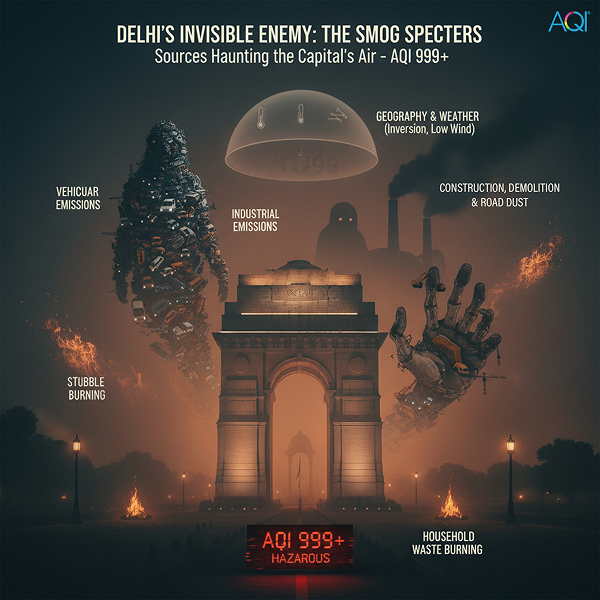Breathing the air in the capital comes at a cost and lately it’s been the cost of life.
According to the latest data from Global Burden of Disease (GBD 2023) released by the Institute for Health Metrics and Evaluation (IHME) and further analyzed by Centre for Research on Energy and Clean Air (CREA), air pollution deaths in Delhi 2023 accounted for nearly 15% of all deaths in 2023.
The data reveals that the toxic air quality and air pollution was the largest health risk for residents and the leading cause of deaths in Delhi in 2023, claiming the lives of an estimated 17,188 people(15%). The other causes that followed were high systolic blood pressure(12.5%), diabetes(9%), high cholesterol(6%) and high body-mass index(5.6%).
As a result, researchers at CREA conclude that the toll of pollution on people’s lives has stayed alarmingly high. Moreover, it even exceeded the deaths caused by high blood pressure and diabetes which is highly concerning.
The Rise in Air Quality Crisis over the years
The data reveals an increase in these numbers going from 2018 to 2023.
|
Year |
Deaths linked to air pollution |
% increase since 2018 |
|
2018 |
15,786 |
– |
|
2023 |
17,188 |
+1,402 (+8.9%) |
Hence, this serves as an important reminder of how deteriorating air quality is going from an issue to an actual crisis. Curbing air pollution, especially with a scientific approach, should in fact be a top priority to add to the quality of life and the life expectancy of millions of people in the capital.
Prime factors of Delhi’s Air Pollution
There are some important local, regional and seasonal factors that are responsible for the unusually high Delhi AQI numbers leading to the thick persistent layer of smog covering the capital.

-
Vehicular Emissions
Cars, two‑wheelers, buses, trucks and diesel generators release huge amounts of particulate matter (PM1, PM2.5, PM10), nitrogen oxides (NOx), carbon monoxide and other toxins. -
Construction, Demolition & Road Dust
Exponentially increasing urban expansion leading to heavy construction and demolition thereby create dust and coarse particles. Unpaved roads and movement leads to road‑dust which hence adds to the particulate load. -
Industrial Emissions
Factories, power plants and other industrial units around the Delhi/NCR region release sulphur dioxide (SO₂), volatile organic compounds (VOCs) and PM. -
Stubble Burning
After harvest, farmers in neighboring states of Punjab, Haryana and Uttar Pradesh burn leftover crop stalks. As a result, smoke and fine particulates drift into Delhi, especially in the post‑monsoon and winter season (October-November), and as a combined effect, pollution levels rise dramatically. -
Household Waste Burning
Burning of biomass (wood, cow-dung), cooking fuels, open burning of waste and moreover Diwali fire‑crackers produce bursts of pollutants and add to the diminishing air quality. -
Geography & Seasonal Weather
Delhi’s topography combined with winter temperature inversion, low wind speeds, and stagnant air consequently leading to pollutants being trapped near the surface not allowing them to disperse.
How the Air Pollution Kills
When fine particles like PM2.5 and PM10 enter the lungs, they reach the alveoli and then travel through the bloodstream, damaging organs over time.

-
Lungs
Chronic alveoli inflammation, leading to lowered oxygen absorption which causes asthma, COPD, and lung cancer. -
Heart
Pollutants thicken the blood and narrow arteries, consequently increasing heart risks and strokes. -
Brain
Tiny particles can reach the brain, impairing cognition function and hence increasing risks of stroke and dementia. -
Immune Systems
Long-term exposure disrupts hormones and weakens immune defense, thus making people more susceptible to infections. -
Children
With higher breathing rates and developing lungs in children, pollutants are absorbed at a higher rate, stunting growth and increasing life-long respiratory risks.
Conclusion
Although, it’s no surprise that air pollution is posing a deadly threat with every passing year, the situation is concerning. The numbers from the statistics are definitely alarming and need to be brought down. Check Delhi’s current AQI on https://www.aqi.in/dashboard/india/delhi/new-delhi to stay updated and take appropriate measures.
One in seven deaths are being caused by ambient air pollution (according to the IHME data for Delhi, 2023) . Therefore, need of the hour is to act towards it responsibly and collectively for the greater and long-term welfare of the community.